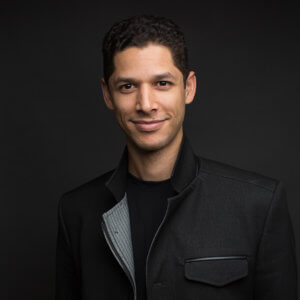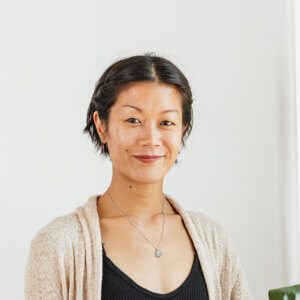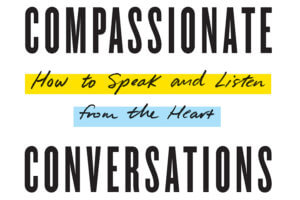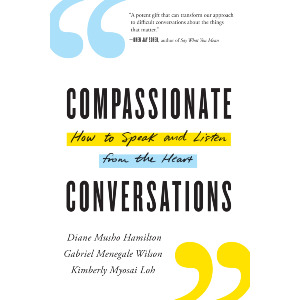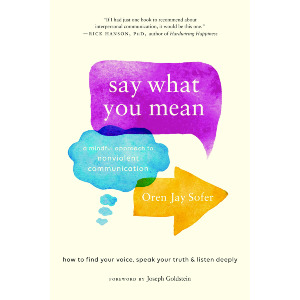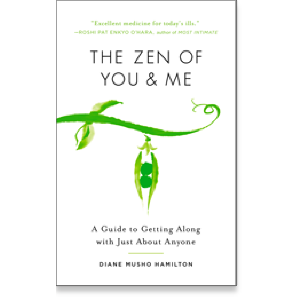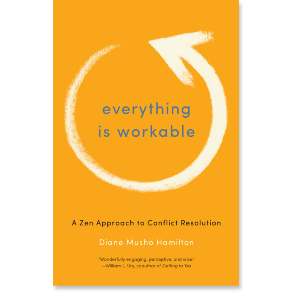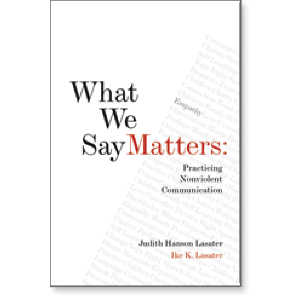An excerpt from Compassionate Conversations
Intention and Conversation
Having a clear intention will literally help us navigate our conversations when we encounter difficult terrain. To enter a conversation (other than one that is simply social) without an intention is like walking into the wilderness without a compass. And yet we engage in conversations all the time without having one, sometimes without even the vaguest idea of how we would like the conversation to go. Rather than being clear as to what we want, whether it’s to assert our truth, to exchange perspectives, to expand our understanding, to learn about another person’s life, or to practice listening, we go in blind and end up stumbling all over the place. We lose ourselves in dense, hidden motives ranging from wanting to be right and proving others wrong, to flaunting our expertise and establishing dominance. We become entangled in trying to impress others or trying to self-protect. We aren’t prepared for feelings when they crop up, so we ignore or simply cope with them, like wading through unexpected expanses of deserts or boggy swamps. Our important conversations are often rambling, aimless, and in the end, unsatisfying and wearying.
We need a reliable reference point, a North Star if you will, for when the going gets tough.
So in our facilitation work, we insist that our groups always agree on a shared intention for a conversation right up-front. Intentions engage the frontal cortex, that part of the brain involved in thinking, planning, and decision-making. It coordinates our thoughts and actions with internal goals and provides us with a healthy focus. As Robert Sapolsky, a Stanford University professor, neuroendocrinologist, and neurobiologist, points out, “The frontal cortex makes you do the harder thing when it’s the right thing to do.” For example, when anxiety begins to grip the room and we then bring our shared intention to mind, it will often restore relaxation, curiosity, and faith in the process.
Gabriel and Diane organized a workshop that brought together a group of black and white friends to explore and transform their racial dynamics. When putting out the call for the workshop, Gabe explicitly said, “This is a space where everybody, black or white, gay or straight, liberal or conservative, and everyone in-between, must agree to challenge themselves, to grow their heart and communication skills and be accountable to the rest of us. Our intention is to transform our unconscious group dynamics into liberated and mutually affirming relationships.”
Typically, most of us engage in conversations about race, gender, politics, or religion not to grow our heart, but to confirm our own personal beliefs and perceptions, including proving others wrong. Group identity and loyalty to our own tribe has far more influence on what we think, believe, and say than we would like to admit. In this workshop, Gabe deliberately formulated the intention to have conversations that were fresh and revealing, and that gave everyone a chance to grow their skill set. To meet these aims, everyone had to buy into the shared intention. Leaders in human development research assert that individual adults can grow and develop new capacities indefinitely: cognitive, emotional, moral, and even one’s sense of self. And this personal growth can translate to broader cultural change, greater political skillfulness, better leadership, and more effective activism.
Gabe interviewed each person who answered the invitation. He wanted to make sure that their intentions and desires were aligned with those of the workshop. After talking with some potential participants it became clear that the workshop was not appropriate for them. Some were more interested in conversations regarding politics or activism; others wanted to do healing rather than relationship work. Some potential participants felt that the premise that we are all responsible for transforming relationships was faulty since some identity groups have obviously dominated and abused others. But Gabe was clear about the purpose of the conversation he convened. The clarity of his intention helped his friends determine if it was the right conversation for them.
There are all kinds of useful conversations, but they may have very different intentions, and therefore outcomes.
An explicit shared intention serves like a cell membrane for conversation. It includes those who share the intention and excludes those who don’t. This is especially important at a time when in many settings we place a premium on inclusion. We may feel that we need to admit anyone who wants to participate in the conversation, but mixed intentions create mixed results. When people have different purposes and outcomes in mind, conversation can grind to a halt. But with a clear direction, when people have primed their frontal cortex to do the hard thing when it’s the right thing to do, conversations can evolve into creative, energized experiences, where more and more perspectives can come to light.
Resistance, Opposition, and Receptivity
An intention does more than create a positive direction; it also creates resistance and opposition. Have you ever set a New Year’s intention and the first thing you notice is how much you resist it? Have you ever noticed when you commit to a discipline how many of your habits that are precisely the opposite come fully into view? For example, if we intend to listen, we’ll begin to notice all the ways that we simply don’t want to. If we intend to hold multiple points of view, we’ll notice all the times we collapse into one solid, unyielding perspective.
The intention to go up highlights the experience of going down; our desire for this points out how often we do that instead.
But resistance is extremely good news because opposition points to exactly the times, places, and patterns that we need to work with in order to grow our skills. Practice takes time; it requires repetition, and encountering obstacles is intrinsic to our growth and skill-building. Resistance functions like gravity, creating drag on our systems, and overcoming it requires galvanizing strength, ingenuity, and determination. Without resistance, our new habits we’re trying to establish don’t become as strong and durable. So working with intention necessarily includes encountering resistance and dealing with opposition.
Our mistakes and failures are golden opportunities to slow down, examine the moment, and look for alternative responses.
For example, Anthony, an African American participant in the training, shared with the group one of his greatest frustrations about white people: “You all unwittingly promote institutional oppression by enjoying its benefits while being blind to how those very same benefits are not extended equally to people of color. For instance, in my university context, the hiring is often done by committees of people in leadership, all of whom are white. So it’s no surprise that they hire more white people. And then they wonder why we don’t have more diversity in our department.” He went on: “I want a white ally who really gets this!”
His passion and intensity had an enormous impact on the room. After a few moments of letting his message sink in, we asked for a white participant to reflect what he or she had heard Anthony say. Lizzie raised her hand and very deliberately repeated what she had heard: “White people, including myself, enjoy the benefits of our systems and institutions while failing to notice how the benefits exclude people of color.” She mirrored his energy and his frustrations.
She continued: “I’ve done a lot of work on myself, and there is a lot more work I need to do around my blind spots. But here’s what I’ve come to recognize about how I perpetuate white supremacy through the institutions I participate with.” She then briefly shared some poignant examples that showed that she understood first hand his point of view. She also shared the efforts she is undertaking personally to account for the impact of her actions.
“Yeah, yeah, that’s fine, but my colleagues don’t see it, and it drives me crazy!” Anthony protested. Now, it’s important to note that the shared intention of this workshop was to deepen our connection to one another through our differences.
“Hold on” Diane said, jumping into the interaction. “Anthony, you just asked for a white ally who shares your understanding, but I didn’t see you take in what Lizzie just said. How did you hear her? Did her message have any impact on you?”
Anthony seemed startled. He paused, looking back at Lizzie. It was a poignant moment to see him take her in, as if for the first time.
“Yes,” he said, “totally. Thank you for that, Lizzie. Wow. I feel way more relaxed knowing you see this, too.” He reflected further. “It’s crazy that I missed that connection, Lizzie. I think I’m so accustomed to being the only black man on my team, where I’m always the sole person pointing out how institutions perpetuate this. And so I failed to listen to what you were saying because I was just gearing up to make my point again.”
It was a small but intimate moment. Anthony’s role as an advocate, which was brave and difficult, actually took over in his conversation with Lizzie and prevented him from forging a connection with an ally he wanted. His takeaway from the weekend was that while in his activist mode he still needs to maintain an openness to receiving potential allies and connections, who may be closer than he thinks.
An intentional conversation, particularly one focused on the growth of our skills, is geared to disrupt our habitual and reactive patterns so that new perceptions, insights, and skills can come in.
Gabe’s intention was to engage differences and to challenge conditioned patterns and biased views so that everyone in his group could genuinely become one another’s allies. His conversation was meant to free everyone to care more deeply about one another and for their work together.
Mutual intentions create powerful experiences. Gabriel’s workshop participants experienced a way of being with themselves and others that they had been longing for. Inevitably, there came a moment when they realized that the workshop would end, and they would return to the many mixed intentions of everyday life. Gabriel joked with the participants: “Yeah, when you walk into Starbucks they won’t share our intention, and they won’t be using our ground rules. Neither will the other drivers on the freeway. Or the people dealing with your credit card or tech problem. Or the passenger sitting next to you on the airplane. Or perhaps some of your colleagues at the university. But your individual intention will affect and shape the way you show up, and that is the greatest power you have. And the freedom, intimacy, and camaraderie that you thought could never be created or sustained in the real world will simply become who you are. And that change is the best contribution you can make to the world.”
The Practice
- The next time you enter into a casual conversation, take a moment to quietly form an intention.
- At several points during the conversation, revisit that intention and allow it to influence your contribution. Notice whether having a clear intention changed your experience.
Share
Related Books
$16.95 - Paperback
$16.95 - Paperback
$12.95 - Paperback
$19.95 - Paperback
$18.95 - Paperback

